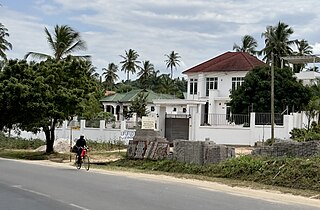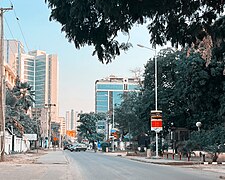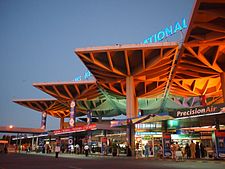
Dar es Salaam is the largest city and financial hub of Tanzania. It is also the capital of the Dar es Salaam Region. With a population of over five million people, Dar es Salaam is the largest city in East Africa and the sixth-largest in Africa. Located on the Swahili coast, Dar es Salaam is an important economic center and one of the fastest-growing cities in the world.

Kariakoo is an administrative ward of the Ilala Municipal Council of the Dar es Salaam Region in Tanzania. Jangwani ward and Mchafukoge ward form the ward's northern and eastern boundaries. The Gerezani and Mchikichini wards border the ward to the south and west respectively. The ward is the home of Simba Sports Club. The name is derived from the swahilization of the British colonial occupation's "Carrier Corps", that used to be based in the area. Today, Kariakoo is mainly known for its large market that spans several city blocks. According to the 2022 census, the ward has a population of 10,246.

Dar es Salaam Region is one of Tanzania's 31 administrative regions and is located in the east coast of the country. The region covers an area of 1,393 km2 (538 sq mi). The region is comparable in size to the combined land and water areas of the nation state of Mauritius. Dar es Salaam Region is bordered to the east by Indian Ocean and it is entirely surrounded by Pwani Region. The Pwani districts that border Dar es Salaam region are Bagamoyo District to the north, Kibaha Urban District to the west, Kisarawe District to the south west and Mkuranga District to the south of the region. The region's seat (capital) is located inside the ward of Ilala. The region is named after the city of Dar es Salaam itself. The region is home to Tanzania's major finance, administration and industries, thus the making it the country's richest region. The region also has the second highest Human Development Index in the country after Mjini Magharibi. According to the 2022 census, the region has a total population of 5,383,728. The region has the highest population in Tanzania followed by Mwanza Region.

Kivukoni is an administrative ward of the Ilala Municipical Council of the Dar es Salaam Region in Tanzania. Kivikoni's name come from the Swahili word meaning "a crossing place". The ward is bordered by Upanga East ward to the west, Kisutu ward to the southwest, and Kigamboni ward across the Kivukoni channel. The ward covers an area of 2.387 km2 (0.922 sq mi). Kivukoni ward is one of the most important wards in the country, as it is home to the Ikulu, which is the home of the president of Tanzania. Kivukoni ward is also home to the National Museum of Tanzania. According to the 2022 census, the ward had a total population of 4,045.

Chanika is an administrative ward of the Ilala Municipical Council of the Dar es Salaam Region in Tanzania. Majohe ward encircles the ward on its northern edge. Tambani Ward of the Mkuranga District in the Pwani Region lies to the south, while Msongola is to the east. The Msimbu and Kisarawe wards of the Kisarawe District in the Pwani Region are also to the west. According to the 2022 census, the ward has a total population of 75,271.

Gerezani is an administrative ward of the Ilala Municipical Council of the Dar es Salaam Region in Tanzania. The Kariakoo and Mchikichini wards border the ward on its northern side. The ward is bordered by Mchafukoge to the east. Ilala ward borders the ward to the west. The ward is bordered to the south by the Keko and Kurasini wards of the Temeke District. Before 1940, the Gerezani ward was constructed for Railways Corporation's White employees. The Mkuki Mall and the Jakaya M. Kiwete Youth Park are located in the Gerezani ward. According to the 2022 census, the ward has a total population of 5,786.

Jangwani is an administrative ward of the Ilala Municipical Council of the Dar es Salaam Region in Tanzania. The Upanga East and Upanga West wards border the ward on its northern side. The ward is bordered by Mchafukoge and Kisutu to the east. Mchikichini ward borders the ward to the west. The ward is bordered to the south by the Kariakoo ward. According to the 2012 census, the ward has a total population of 17,647.

Kinyerezi is an administrative ward of the Ilala Municipal Council of the Dar es Salaam Region in Tanzania. The wards of Kinondoni MC are bordered to the north by Msigani, Saranga, and Kimara wards of Ubungo MC. The ward is bordered to the east by the wards of Segerea and Kimanga. Kipawa, Ukonga, Gongolamboto, and Pugu are to the south. The ward is bordered by Kwembe to the west. According to the 2022 census, the ward has a total population of 62,480.

Kisutu is an administrative ward of the Ilala Municipal Council of the Dar es Salaam Region in Tanzania. Upanga East ward and Kivukoni ward both border the ward to the north and north-east. The ward is bordered to the south by Mchafukoge ward and to the west by Jangwani ward. The ward hosts the Channel 10 Television Station formerly known as Dar es Salaam Television Station at Zaramo Street in Kisutu ward. In 2022, the population of the ward was 6,364.

Mchafukoge is an administrative ward and district capital of the Ilala district in the Dar es Salaam Region of Tanzania. Kisutu and Kivukoni wards form the ward's northern boundary. The Dar es Salaam Harbor forms its eastern border. The Temeke District wards of Kurasini and Keko border it on the south. Kariakoo and Jangwani wards border the ward to the west. The ward is home to the Uhuru Monument, the Central Railway Station, and the headquarters for Tanzania Revenue Authority at Mapato House. In 2022, the population of the ward was 7,999.

Mchikichini is an administrative ward of the Ilala Municipical Council of the Dar es Salaam Region in Tanzania. Upanga West forms the ward's northern boundary. Its eastern border is formed by Jangwani and Kariakoo. The ward is bordered to the south by the Gerezani and Ilala wards. The Kinondoni District wards of Kigogo, Magomeni, and Mzimuni border it on the west. The ward is home to the Karume Market, one of the largest markest in the city. According to the 2012 census, the ward has a total population of 25,510.

Msongola is an administrative ward of the Ilala Municipical Council of the Dar es Salaam Region in Tanzania. Kivule and Chamazi border the ward to the north. By Chanika and Majohe to the west. Mkuranga and Tambani (Exclave) wards of the Mkuranga District of the Pwani Region border the ward on its southern side. The Main Tambani ward of Pwani Region's Mkuranga District borders the ward on the east. According to the 2012 census, the ward has a total population of 81,646.

Tabata is an administrative ward of the Ilala Municipical Council of the Dar es Salaam Region in Tanzania. The ward is bordered to the north by the Ubungo MC wards of Makuburi and Mabibo. Kigogo of Kinondoni MC form the eastern boundary of the ward. Vingunguti and Buguruni are to the south. lastly, the Segerea and Kimanga wards in the west. According to the 2012 census, the ward has a total population of 74,742.

Ukonga is an administrative ward of the Ilala Municipical Council of the Dar es Salaam Region in Tanzania. Kinyerezi forms the ward's northern boundary. To the east is Kipawa, and to the south are Kivule and Majohe. Gongolamboto ward is to the west. According to the 2012 census, the ward has a total population of 80,034.

Upanga East is an administrative ward of the Ilala Municipical Council of the Dar es Salaam Region in Tanzania. Kivukoni forms the ward's northern boundary. Kisutu borders the ward to the east, and Mchafukoge and Jangwani border it to the south. By Upanga West, to the west. The ward is home to the Tanzanian National Library. According to the 2022 census, the ward has a total population of 9,317.

Pugu is an administrative ward of the Ilala Municipical Council of the Dar es Salaam Region in Tanzania. Kinyerezi and Kwembe ward of Kinondoni MC form the ward's northern boundary. The ward is bordered by Majohe to the south and Gongolamboto to the east. In the west the ward is bordered by Kisarawe ward of Kisarawe District in the Pwani Region. The ward is named after the Pugu Hills, which form its western border and are home to the Pugu Hills Forest Reserve and the Kazimzumbwi Forest Reserve, two of some of the world's oldest forests. According to the 2012 census, the ward has a total population of 49,422.

Gongolamboto or also Gongo la Mboto is an administrative ward of the Ilala Municipical Council of the Dar es Salaam Region in Tanzania. Kinyerezi ward encircles the ward on its northern side. Ukonga is to the east, and Majohe Ward is to the south. Pugu is to the west. The ward is known for the 2011 Dar es Salaam explosions. In old colonial maps the area is spelled Kongoramboto. According to the 2022 census, the ward has a total population of 63,043.

Kimanga is an administrative ward of the Ilala Municipical Council of the Dar es Salaam Region in Tanzania. The wards of Ubungo MC are bordered to the north by the wards of Makuburi and Kimara. The ward is bordered by Segerea to the south and Tabata to the east. Kinyerezi borders the ward on its western side. According to the 2022 census, the ward has a total population of 50,340.

Kivule is an administrative ward of the Ilala Municipal Council of the Dar es Salaam Region in Tanzania. Ukonga and Kipawa border the ward's northern boundary. Kitunda borders the east of the ward. Chamazi and Msongola are in the south; the former is located in Temeke MC. Majohe is to the west. According to the 2022 census, the ward has a total population of 88,273.

Majohe is an administrative ward of the Ilala Municipical Council of the Dar es Salaam Region in Tanzania. The communities of Ukonga, Gongolamboto, and Pugu border the ward on the north. By Kisarawe Ward in Kisarawe District in Pwani Region, to the west. Chanika and Msongola form the southern boundary of the ward. Kivule borders the ward on its eastern side. According to the 2012 census, the ward has a total population of 81,646.




























